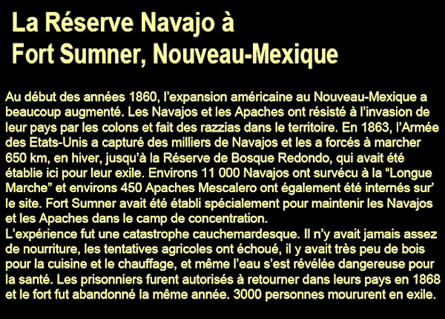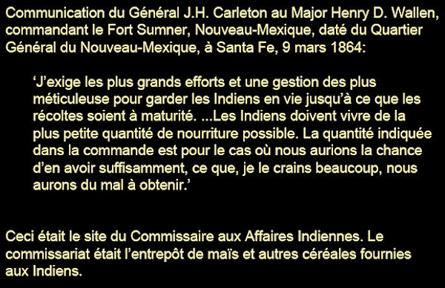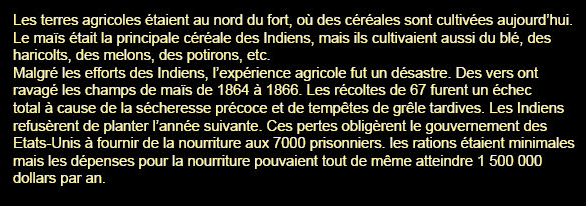Dans la seconde moitié du XIXème siècle, la “conquête de l’Ouest” s’est intensifiée. En 1846, les Etats-Unis avaient attaqué le Mexique, indépendant depuis peu, et acquis une énorme portion de territoire, par le Traité de Guadalupe-Hidalgo de 1848. Avant, les colons voulaient surtout s’emparer de terres agricoles et avaient peu d’intérêt pour les terres rocheuses et désertiques du Sud-ouest. Cependant, dans la seconde moitié du XIXème siècle, les gens commencèrent à chercher de l’or et autres ressources minérales.
Dans les années 1860, l’Armée Américaine avait des postes militaires dans le Sud-ouest, sous prétexte que les Navajos et les Apaches faisaient des razzias dans la zone. Dans la région correspondant aux états actuels d’Arizona et du Nouveau-Mexique, les colons capturaient des femmes et des enfants Autochtones comme esclaves, ce qui revenait moins cher que d’acheter des esclaves Africains. Les guerriers Autochtones essayaient de libérer les captifs et faisaient des razzias dans ce but. Cependant, dans les années 1860, la rumeur s’est répandue parmi les Blancs qu’il devait y avoir de l’or dans le Territoire Navajo. Un de ceux qui crurent en cette rumeur était le Colonel Kit Carson. Il réussit à persuader son supérieur, le Général Carleton, qu’il était nécessaire de se débarrasser des Navajos.
L’Armée dirigée par Kit Carson attaqua le Territoire Navajo, tandis que Fort Sumner – nommé en mémoire du Général Edwin Vose Sumner – était construit, sur un site appelé Bosque Redondo par les Espagnols. Au cours de l’hiver 1863-64, l’armée de Carson tua des Navajos, détruisit les récoltes, et captura tous les Navajos qui n’avaient pu leur échapper. Dans le Canyon de Chelly, où les gens se cachaient dans des grottes, l’Armée détruisit tout ce qui pouvait pousser, entre autres les pêchers dont les Navajos étaient si fiers. Certains guerriers réussirent à se cacher dans les nombreuses grottes et canyons de la région. Mais des milliers de Navajos furent faits prisonniers et forcés de marcher sur environs 650 km, en hiver, jusqu’à Bosque Redondo. Beaucoup moururent en route. En particulier les enfants et les personnes âgées, moururent de faim et d’épuisement, ou se noyèrent en devant traverser des rivières.

Sur le lieu où ils devaient être détenus – appelé ‘réserve’, mais en réalité le premier camp de concentration de l’histoire moderne, avec intention d’extermination – ils devaient produire pour assurer leur survie. Ils devaient planter des céréales et autres produits alimentaires.

Cependant, l’endroit était particulièrement inhospitalier, ils manquaient de bois, et l’eau de la rivière Pecos était alcaline, non-potable, la boire les rendait malades, et ne convenait même pas à l’irrigation. Quelques centaines d’Apaches Mescalero furent également détenus dans le camp.
Bien que les soldats du fort soient supposés surveiller le camp, et bien entendu, empêcher les prisonniers de s’évader, ils fermaient les yeux quand des Comanches – alors ennemis des Navajos et des Apaches, et au besoin collaborateurs – les attaquaient.

Après plusieurs années de mauvaises récoltes, durant lesquelles l’Armée devait fournir aux prisonniers des rations minimales, ce qui coûtait tout de même de l’argent, il fut décidé que ça coûterait moins cher de laisser les survivants rentrer ‘chez eux’, dans une réserve dessinée par un rectangle sur une carte, dans le cadre du Traité du 1
er juin 1868. Les survivants ont probablement dû leur salut au fait que leur enfer ait eu lieu pendant la Guerre de Sécession. Ça réduisait énormément le budget de l’armée pour d’autres actions, et beaucoup de militaires de la région avaient choisi le camp des Confédérés, “les Sudistes”.
Les survivants rentrèrent chez eux, c’est-à-dire d’où ils venaient, n’ayant pas appris à reconnaître un rectangle abstrait dans le paysage. Depuis, la Réserve Navajo a été agrandie à plusieurs reprises, mais ils n’ont toujours pas récupéré leur Territoire ancestral, entre les Quatre Montagnes.
L’histoire de Hwééldi a été racontée de génération en génération. En 2009, Camille Manybeads Tso a raconté dans un film, “In the Footsteps of Yellow Woman”, l’histoire de son arrière arrière-grand-mère, qui avait réussi à se cacher avec son bébé et à échapper à la Longue Marche. Le film est passé en France, dans le cadre du festival Alter’Natif, à Nantes. Le film de Klee Benally, “Power Lines” – sorti aux Etats-Unis en 2015 et à Paris en 2016 – est d’un bout à l’autre parsemé d’allusions à Hwééldi, évènement crucial dans l’histoire de tous les Navajos.

Les photos ont toutes été prises sur le site du camp. Il a été déclaré Monument de l’état du Nouveau-Mexique en 1968. Un mémorial, qui héberge un musée, a été conçu par l’architecte Navajo David N. Sloan. Il a été ouvert le 4 juin 2005. Le site est actuellement géré par le Service des Sites Historiques du Nouveau-Mexique, qui dépend du Service des Affaires Culturelles du Nouveau-Mexique. Donc, les histoires ont probablement été quelque peu ‘adoucies’, croyez bien qu’en réalité, ça a été pire. Le site est proche de la tombe de Billy The Kid, et se trouve sur la Route Billy The Kid. Dans les guides touristiques et sur les panneaux indicateurs, vous ne trouverez que “Tombe de Billy The Kid” comme indication. Les racistes préfèreront toujours un voleur blanc à des Autochtones assassinés.
Christine Prat












